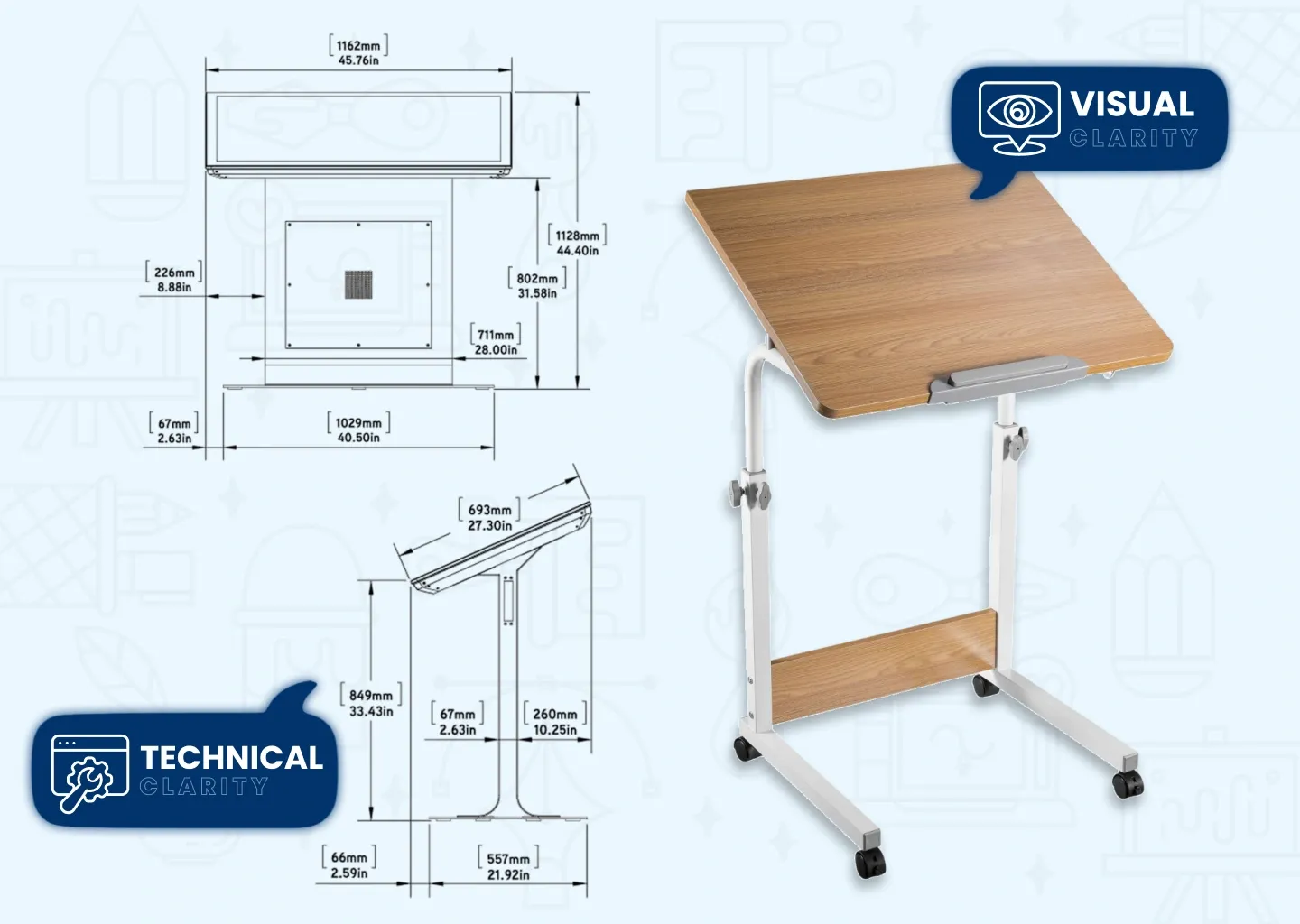
In millwork, perfection and precision are the key aspects of any drawing. From the first measurement to the last finish, everything should be planned before tools shape the materials. Millwork shop drawings services play a crucial role in this process, helping to transform your dream vision into flawless craftsmanship.
Whether you prefer the straightforward clarity of 2D or the in-depth immersive detail of 3D, both formats bring their strengths to the table. The real question is – which one is right for your project?
To help you decide, this blog will cover all aspects, differences, and when to use 2D and 3D in detail.
But, first, let’s take a glimpse at shop drawings.
What are Shop Drawings at Millwork?

The in-depth, detailed drawings present the exact manufacturing details to build specific components. It includes minute details such as precise measurements, materials, finishes, and the implementation of assembly methods. The focus area of this drawing is on specific items, including doors, cabinets, wall panels, furniture, and more.
Once the project begins execution, there’s no turning back. That’s why these millwork drawing services are so important. A single wrong measurement or action can lead to costly repairs. It will also result in greater time consumption.
2D Shop Drawings- Old and Traditional
These are the flat drawings that have been the industry standards for a long time until 3D drawings came into use. In 2D millwork drafting, the two-dimensional drawings presented the project most simply with only section views.
Why Are 2D Shop Drawings Preferred?
- These drawings were easy to interpret for cross-functional teams.
- In comparison to 3D drawings, these drawings were cost-effective, making them ideal for budget-conscious projects.
- These drawings are known for their clarity, precision, and universality.
- This traditional approach also keeps communication straightforward, especially in projects where multiple contractors- joiners, architects, and builders must stay aligned.
But, 2D millwork drafting has some limitations. Let’s explore.
Read More: Why 2D Drafting is useful for Architectural Drawings?
Limitations of 2D Shop Drawings
- It provides limited views, making it challenging to get a comprehensive view of the full design at once.
- Since these are flat designs, it becomes tough to interpret how different parts of the millwork will work together.
- These designs are less suitable for complex designs that need precise visualization.
- It can sometimes bring vagueness to complex or highly customized projects.
This highlights the difference between 2D and 3D millwork shop drawings for projects that require higher visual clarity.
Confused between 2D and 3D shop drawings?
We’ll help you pick the best and deliver it with unmatched accuracy.
3D Shop Drawings- Modern and Immersive Approach
3D shop drawings have taken the millwork visualization to the next level. These amazing drawings provide a lifelike view of the final product from every angle, often created by various tools. Through these drawings, stakeholders visualize the design as it will appear in the finished space.
Why Are 3D Shop Drawings Mostly Preferred These Days?
- With these drawings, complex designs with in-depth details are easy to understand. This gives good scope for discussions and visible minute changes.
- The entire approval process becomes significantly easier with seniors and even more so with the clients.
- It enables easy scaling or adjustments without redrawing from scratch.
- Due to better visual clarity, it reduces the multiple revision requirements during the fabrication stage.
When comparing 3D vs 2D shop drawings for architectural millwork, the right choice can significantly reduce guesswork in the process. But, this also has limitations, let’s see.
Shortcomings of the 3D Shop Drawings
- The 3D shop drawings are time-consuming and pocket-heavy.
- These drawings demand high-tech expertise and computing resources.
- It is not considered ideal for small projects.
Comparative Analysis of 2D and 3D Shop Drawings
| Aspect | 2D | 3D |
| Interpretation | Relies heavily on the viewer’s technical skill to visualize the finished product from multiple flat views mentally. | Requires little interpretation skill, as the model is seen in its finished form, making it easy for even non-technical stakeholders to grasp. |
| Communication & Collaboration | Works well in traditional workflows with established industry professionals who are used to interpreting technical drawings. | Improves multi-disciplinary collaboration, especially when teams are remote or unfamiliar with the project’s finer details. |
| Number of Revisions | Alterations can be more time-consuming, as changes must be redrawn in multiple views for accuracy. | Allows quick design updates that reflect instantly across the whole model, saving significant revision time. |
| Technology & Resource Needs | Minimal software and hardware requirements, making it accessible for smaller workshops or budget-focused teams. | Requires advanced design software, skilled operators, and strong computing resources, which can increase project costs. |
This section highlights the crystal clear difference between 2D and 3D millwork shop drawings and helps teams choose the right tool for the job.
Picking 2D or 3D- Make a Smart Choice in Different Situations for Your Millwork Project
Use 2D Shop Drawings when-
- You have straightforward projects such as basic cabinetry or mouldings.
- Projects have limited timelines, and speed is what matters more than in-depth visualization.
- Projects with a limited budget require careful consideration of the financial aspects.
Use 3D Shop Drawings when-
- Client-facing design stages where buy-in is critical.
- Complex projects with intricate details or unusual shapes.
- There are marketing and stakeholder presentations where photo realistic visuals add impact.
This balance between the two formats highlights the difference between 2D and 3D millwork shop drawings. It allows professionals to select the approach that matches their project scope.
Also Read: How Millwork Drafting Services Can Be Cost-Effective?
An Overview of the Global Millwork Market

According to the reports in Metastat, the global millwork market is growing at a rapid pace and is expected to reach $146 billion by 2032. This is currently growing at a CAGR of 3.4%, between 2025-2032.
Sounds interesting.
This growth reflects the increasing demand across various industries for reliable and cost-effective materials used in construction, furniture, and interior design. By 2026, there are predictions that the market size will pass $200 billion, reflecting how millwork is adapting to current requirements and advanced technologies.
If we look region-wise, here is some data that will surprise you-
- North America currently leads the market at 35%,
- Asia Pacific at 30%,
- Europe at 20%,
- Latin America at 10% and many more.
After reviewing all this data, we note that choosing between 3D vs 2D shop drawings for architectural millwork is a decision. It significantly impacts the precision and visualization of your designs. The millwork industry continues to adapt and grow in the market. Selecting the right drawing method becomes essential. It is vital to meet both budget and quality expectations.
Final Words
Selecting between 2D and 3D millwork shop drawings is about precision and preferences. At Shalin Designs, we offer millwork drafting services that provide smooth and high-quality outputs, supporting every stage of production. Whether you need traditional 2D layouts or visually appealing and easy-to-understand 3D designs, we help you choose the best approach for your projects. Connect with us today and see why professionals worldwide trust us for precision and reliability.



